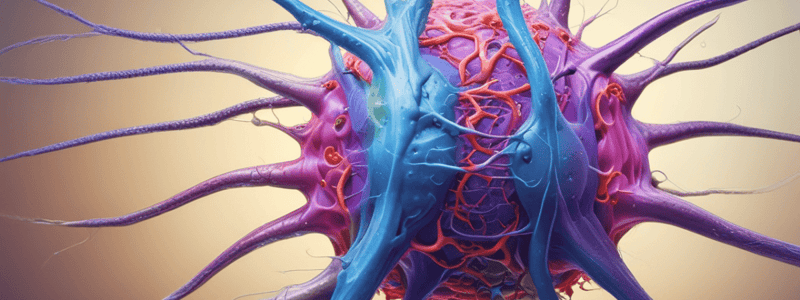Podcast
Questions and Answers
What are the standard anatomical parts of a neuron?
What are the standard anatomical parts of a neuron?
- Soma, dendrite, axon; soma contains the nucleus, dendrites receive signals, and axons send signals (correct)
- Axon hillock, dendrite, soma; axon hillock receives signals, dendrites are the main cell body, and somas send signals
- Axon, nucleus, cell body; axons receive signals, the nucleus is the main cell body, and cell bodies send signals
- Dendrite, nucleus, axon; dendrites receive signals, the nucleus is the main cell body, and axons send signals
What is the sequence of events that takes place when a neuron fires?
What is the sequence of events that takes place when a neuron fires?
- Hyperpolarization, resting state, depolarization; hyperpolarization leads to the resting state which then triggers depolarization
- Resting state, depolarization, hyperpolarization; resting state occurs when the neuron fires, leading to depolarization and then hyperpolarization
- Depolarization, repolarization, hyperpolarization; depolarization is the neuron firing, followed by repolarization and then hyperpolarization (correct)
- Resting state, action potential, repolarization; the neuron goes from resting to firing an action potential and then repolarizes
What is the role of hyperpolarization in propagating a nerve impulse?
What is the role of hyperpolarization in propagating a nerve impulse?
- Hyperpolarization triggers the initial depolarization in a neuron
- Hyperpolarization helps in reducing the neuron's excitability after firing (correct)
- Hyperpolarization is not involved in propagating nerve impulses
- Hyperpolarization increases the rate of firing in a neuron
What is the difference between EPSPs and IPSPs in typical nerve function?
What is the difference between EPSPs and IPSPs in typical nerve function?
What are the components of the peripheral nervous system?
What are the components of the peripheral nervous system?
How do reflex arcs work?
How do reflex arcs work?
What is the primary function of ligand-gated channels in propagating a nerve impulse?
What is the primary function of ligand-gated channels in propagating a nerve impulse?
How do EPSPs differ from IPSPs in the context of typical nerve function?
How do EPSPs differ from IPSPs in the context of typical nerve function?
In neuron function, what role do potassium channels primarily play?
In neuron function, what role do potassium channels primarily play?
What distinguishes the autonomic nervous system from the somatic nervous system?
What distinguishes the autonomic nervous system from the somatic nervous system?
What is the main function of hyperpolarization in propagating a nerve impulse?
What is the main function of hyperpolarization in propagating a nerve impulse?
How do sympathetic and parasympathetic nervous systems differ in their effects on body functions?
How do sympathetic and parasympathetic nervous systems differ in their effects on body functions?
Flashcards
Neuron parts
Neuron parts
Soma (cell body), dendrites (receive signals), axon (sends signals).
Action Potential Sequence
Action Potential Sequence
Depolarization (firing), repolarization (returning to resting), hyperpolarization (undershoot).
Hyperpolarization role
Hyperpolarization role
Reduces neuron excitability after firing, preventing immediate repeated firing.
EPSP vs. IPSP
EPSP vs. IPSP
Signup and view all the flashcards
Peripheral Nervous System
Peripheral Nervous System
Signup and view all the flashcards
Reflex Arc
Reflex Arc
Signup and view all the flashcards
Ligand-gated Channels
Ligand-gated Channels
Signup and view all the flashcards
EPSP outcome
EPSP outcome
Signup and view all the flashcards
Potassium Channels
Potassium Channels
Signup and view all the flashcards
Autonomic vs Somatic NS
Autonomic vs Somatic NS
Signup and view all the flashcards
Hyperpolarization's function
Hyperpolarization's function
Signup and view all the flashcards
Sympathetic vs Parasympathetic
Sympathetic vs Parasympathetic
Signup and view all the flashcards




